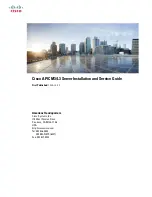
QuVIS Media File Types
Files that contain video and audio data are commonly referred to as clips or media files. There are several types of
media files that can be created and played by QuVIS video servers. Determining the type of media file to use is very
important. Each media file type is constructed differently in order to efficiently achieve the intended use of the
content (video and/or audio).
Aside from the video and audio format of the media file, there are three settings that serve as the foundation of a
media file. These settings are: QuVIS Media Format (QMF), Maximum Data Rate (MDR) and Clip Form.
QuVIS Media Format (QMF)
The QuVIS Media Format or QMF is a compatibility switch that identifies different file format standards used by
QuVIS video servers. There are currently three modes: QMF1, QMF2 and QMF3.
QMF1 – This QMF setting is used to identify collapsed clips (interleaved video and audio) that may be
played by the first generation QuVIS video servers, the QuBit, running a QuVIS Soft Release (QSR) of 1.x.
QMF1 content may be played and created by current products running QSR 2.x or 3.x releases. This
legacy clip file format has built-in controls that limit the options available for MDR, Metadata and Clip Form
in order to maintain playback compatibility with older 1.x QuBits.
QMF1 clip settings
•
MDR = Maximum of 30MB/sec
•
Metadata = Not supported
•
Clip Form = Collapsed only (interleaved video and audio)
QMF2 – This QMF setting is used to identify media files that may only be created or played on QuVIS
video servers running a QSR release of 2.x or greater, including QSR 3.x. The QuVIS Acuity, Cinema
Player, Encore, Acuity and QuBit product line (ST, EL and DS) natively supports this QMF setting. QMF2
supports features that are tied to specific levels of hardware (circuit cards) that are not available for 1.x
version QuBits.
QMF2 clip settings
•
MDR = 30 and 60MB/sec supported
•
Metadata = supported
•
Clip Form = Collapsed and expanded
QMF3 – This QMF setting is used to identify the JPEG2000 encoded Digital Cinema media files. QMF3 is
not a selectable setting but is automatically configured by selecting JPEG2000 Digital Cinema format files.
QMF3 Digital Cinema clip settings
•
MDR = JPEG2000 250mb/sec
•
Color Space = XYZ
•
Clip Form = Collapsed and expanded
Maximum Data Rate (MDR)
MDR is used to set the upper data rate limit of a media file. These limits are set to correspond to the bandwidth
capabilities of the QuVIS video server that is recording the content or intended to play the content. A 1.x QuBit for
instance can only support a maximum date rate of 30MB/sec. Current products running QSR 2.x or greater support
a maximum data rate of 60MB/sec.
Aside from the product model and system software version, another important element that determines the ability to
record or play MDR 60 content is the number of drives that make up a QuVIS storage volume. A single-drive
volume can only support a maximum data rate of 30MB/sec. Multi-drive volumes (2 or more drives) will support
MDR 60 and is capable of sustaining data rates of 60MB/sec.
QuVIS Acuity
™
Page 54
QSR Version 3.3
Summary of Contents for Acuity
Page 1: ......
Page 152: ...Keyboard Hotkeys Description ENTER Complete current edit QuVIS Acuity Page 151 QSR Version 3 3...
Page 190: ...QuVIS Acuity Page 189 QSR Version 3 1...
Page 200: ......
















































